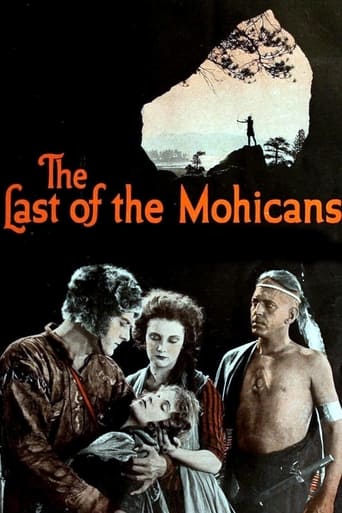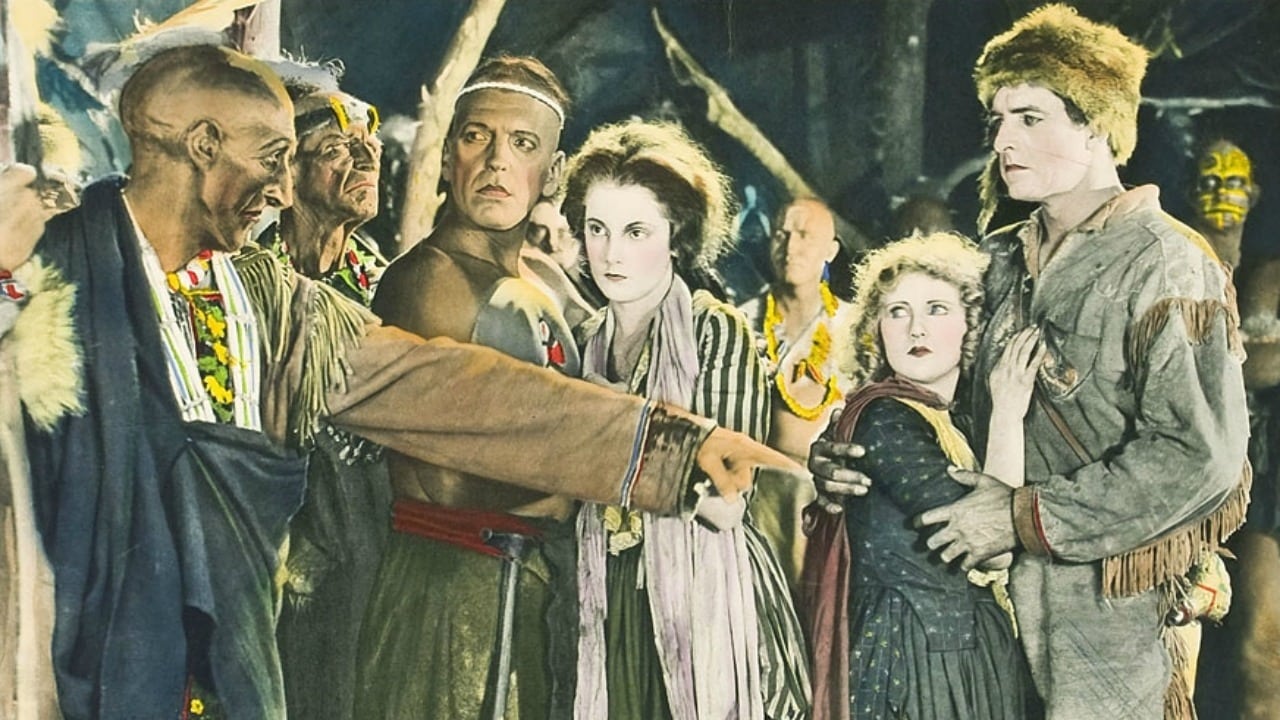antoniocasaca123
The 1992 version is great, with Daniel Day Lewis and Madeleine Stowe in full swing and establishing an impressive and sensual chemistry as the romantic pair of the movie, the best that has ever been seen in the movies. But this 1920 version is also very good and was a surprise to me, as there are several changes in the final part of the film compared to 1992, being the much more tragic outcome in this 1920 version (but equally powerful and realistic, maybe even more) than in the latest version. Silent movies continue to be a constant (good) surprise to me. The actress Barbara Bedford is fantastic, I think she is the great star of the movie. The 1920s are undoubtedly one of the richest and most creative decades in film history.
mhesselius
I just saw "Last of the Mohicans." I didn't expect much. I had seen other adaptations: the 1936 George B. Seitz movie and the Michael Mann remake of 1992. To me they all seem to lack the spirit of what is admittedly a rambling novel whose provocative subject matter is only partially realized. Cooper's problem was execution; he didn't understand how severely his story was compromised by unnecessary characters, needless plot devices, and ceaseless talk. Latter day film-makers steered around Cooper's problem by ignoring him and creating a story of their own, but in doing so they lost what was fine in his work.Director Maurice Tourneur does not ignore Cooper, although he does cut through the crap. In a non-talking film the characters can't yap on the way they do in Cooper's fiction. Hawkeye's role is reduced. He has few scenes and is not the romantic lead Randolph Scott and Daniel Day Lewis would be in later adaptations. He is the homely, awkward, asexual woodsman Cooper describes. Tourneur chooses, rather, to focus directly on the tragic romance at the novel's core, between British colonial Cora Munro and Mohican hunk Uncas. He thereby rescues the film from becoming another "Birth of a Nation" with Wallace Beery's Magua standing in for Griffith's black-faced white men who try to rape white women.Tourneur's technique is impressive. Camera perspective, lighting, and editing are well in advance of what was being done in 1920. The action on the Eastman print I saw seems a little fast. I'm not sure if it runs at the correct projection speed. Tourneur obviously under-cranked his camera during action sequences to give actors and extras the appearance of furious motion. These are only small criticisms, however.As in all his films Tourneur reined in the actors' exaggerated facial expressions and theatrical gestures, which is perhaps why there are so many title cards explaining the actors' motivations. Barbara Bedford is restrained and natural as Cora, some might argue too restrained to be the passionate, dark-haired heroine of Cooper's novel. But Tourneur lets Bedford's quiet beauty act as a veneer masking a volatile nature. Her defiance of social and feminine conventions – showing attraction for a Native warrior, and impulsively sacrificing herself to protect her sister in the Indian town – affects us all the more because of her stillness. In Garbo such stillness was praised as mystique. So perhaps it is no coincidence that Tourneur's protégé Clarence Brown, who finished this film when Tourneur was injured, guided Garbo's early career beginning with "Flesh and the Devil" in 1926.
Snow Leopard
This is a fine movie adaptation of the classic story of "The Last of the Mohicans", for its time certainly, but in many respects it has held up at least as well as just about any other screen version of the story. The scenario emphasizes the gist of the story, develops most of the main characters efficiently, and at the right times creates a good sense of danger and suspense.The story is by and large the one familiar from the novel, set in the Seven Years War (which in the USA is often called the 'French and Indian War'), with the British and French relying heavily on their allies among the various native tribes of North America. The Mohicans were the tribe that had occupied some of the first land to be taken by European colonists, and thus already in 1757 had almost disappeared. In the story, they are down to one father and one son, which adds considerable poignancy to events.The script in this version makes the interesting choice to deemphasize the role of the Mohicans' friend Hawkeye in the course of the story, instead portraying the two Indians, Uncas and Magua, as the primary figures in the fighting and in the ongoing battle of wits. Cooper's novel contains many lengthy descriptive passages, and they are omitted here, replaced instead by many location shots that efficiently and effectively suggest the atmosphere of the time, without using words.Albert Roscoe (as he was billed here) stars as the courageous Mohican Uncas, Wallace Beery (always good in the role of a heavy) plays the treacherous, mean-spirited Magua, and Barbara Bedford is Cora, whose safety becomes one of the crucial issues in the conflict.While the story is largely the same, this has a much livelier pace than the novel, and it really works quite well. The photography is very good, especially for 1920. It is well worth seeing for itself, and as an example of a good approach to adapting a classic novel into a movie.
Cineanalyst
This film is well photographed, as are most of the films I've seen that are directed by Maurice Tourneur. The framing and composition of shots are apt, except occasionally when it is theatrical. Much of the action happens outside, which helps--freeing the camera and providing scenery. There are some nice lighting effects: use of low-key lighting, nighttime photography, the flickering light against a wall to represent candlelight and such. There are some silhouette shots, which seem to be a trademark in Tourneur's films. The tinting, too, adds to the film's beauty.Some moments show a resemblance to D.W. Griffith and Billy Bitzer's work, such as "The Battle at Elderbush Gulch" and "The Birth of a Nation". There are the iris shots and actor's approaching the camera, both of which were likely invented by Griffith and Bitzer. The battle scene at the fort is rather Griffith-like. Impressively innovative is the pan of the faces of Magua and Uncas and then them rushing towards the camera, as they begin fighting. The main pictorial schema for this film, and I think it's a good one, if not entirely original, is switching from distanced views to intimate shots, thus taking in the breadth of the scenic environment and concentrating on the story's action. This can be seen in the battle scenes, the cliff scene and pretty much every other important scene outside.I've referred to this as Tourneur's film, but that's doubtful. Clarence Brown, Tourneur's longtime assistant, directed most of the shooting, due to Tourneur being ill. In the early days without detailed shooting scripts, it's questionable as to how much of the film was the conception and design of Tourneur, but Brown having worked under him, the issue is probably moot. Perhaps, the poor use of the same set for fictionally different locations, made obvious by the successive cuts, in addition to other minor amateurish mistakes, can be blamed on inexperience.Of worse error are Caucasians playing Indians and the film's occasional condescension and racism, although the film can be commended for its generally respectful treatment. As well, intertitles do replace some action and acting in this film, as fellow commenter Sorsimus criticized. And, the story contrives three moments where dark hair faces the choice of replacing herself for yellow hair as Magua's captive. The film appears rather unpolished at times, as a result. These are rather minor, or commonplace, problems, though.This is a promising early film for Brown, at the peak of Tourneur's career. Tourneur, a pioneer of the medium, dealt with a variety of stories, so from there one can't characterize his body of work easily; it's in cinematography that a characteristic style of innovation and the use of the best of film grammar known can be seen. For Brown, his films would surpass the visual brilliance of his master, with films such as, say, "The Flesh and the Devil". Here, it seems he wisely worked from the style of Tourneur to create some very interesting photography.


 AD
AD


